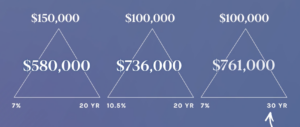Details Are Part of Our Difference
Embracing the Evidence at Anheuser-Busch – Mid 1980s
529 Best Practices
David Booth on How to Choose an Advisor
The One Minute Audio Clip You Need to Hear
Author: Charles Kafoglis
Hey Hill, how can I…

At Hill Investment Group, we recognize that when a few clients raise the same question, it’s likely that more have similar thoughts. To better serve you, we’re introducing a new segment in our newsletter where we’ll address common questions and how we approach them. To submit questions for future newsletters, email us at info@hillinvestmentgroup.com
Hey Hill, how can I reduce my IRA Required Minimum Distributions (RMDs) and related retirement tax liabilities?
Contributing to traditional IRAs and 401(k)s is a great way to save for retirement. You get a current-year tax deduction, and your money grows year in and year out without being hindered by taxes. The IRS never sleeps. You either pay them now or later. Therefore, at some point, when you need to access these tax-deferred funds, whether that’s by choice or because you must begin taking Required Minimum Distributions (RMDs), any withdrawals you make from your IRA will be subject to ordinary income tax rates. Therefore, it’s critical to understand the different ways to plan for this most effectively.
First, what is an RMD? The IRS requires that an individual begin taking systematic withdrawals from their pre-tax/qualified retirement accounts (e.g., 401(k), 403(b), traditional or rollover IRAs, etc.) at age 72, 73, or 75, depending on your date of birth. This annual required mandatory distribution is known as an RMD. You can calculate your projected RMD using the Schwab RMD Calculator.
While we want our pre-tax retirement accounts to grow and be as large as possible, the taxes that will ultimately be due also grow. An investor can use three strategies to optimize this tradeoff between growth and taxes.
ROTH Conversions
One strategy is to convert assets from your traditional or rollover IRA to a Roth IRA before RMDs begin. When investors are in a low tax bracket, there are often many years between retirement and the RMD start date. Therefore, investors can save a lot in taxes by converting assets during a lower income period.
Let’s consider an example to showcase how this strategy works.
Betsy has just retired at 65 and has $500,000 in her traditional IRA. She must begin taking RMDs at age 73. Her projected RMD at 73 is about $30,000 per year. This amount might bump Betsy to a higher tax bracket in the future and may even increase her Medicare premium costs.
Since Betsy is retired, her reduced income level moves her from the 22% tax bracket to the 15% tax bracket. She decides to convert some of her traditional IRA into a Roth IRA. She withdraws $40,000 annually for the next five years from her pre-tax traditional IRA to fund her Roth IRA. Each year, she pays income tax on the $40,000 distribution but at her new, lower tax rate. This is known as a Roth Conversion. Her money has moved from one tax-advantaged account (the Traditional IRA) to another (the Roth IRA), the taxes are “pre-paid” at a lower rate, and her invested money in the Roth will continue to grow and never be taxed again. By age 70, she has successfully reduced her traditional IRA balance by $200,000, and her RMD at 73 is now projected to be only $18,000 rather than $30,000.
QCDs
But there is even more she can do. Starting at age 70.5, the IRS allows you to distribute funds from your IRA without paying taxes if the funds are gifted directly to a qualified charitable organization. Betsy currently gives $10,000 to her church annually by writing a check from her bank account. Instead, she should direct her Hill advisor to make those payments on her behalf from her IRA. This approach takes advantage of the Qualified Charitable Distribution or QCD. If Betsy’s RMD following her Roth Conversion was projected to be $18,000, by donating $10,000 from her IRA, she will only be taxed on $8,000. By planning 8 years into the future, Betsy’s Hill Advisor has reduced her RMD from $30,000 to $8,000, she will pay less in taxes, and she has a growth Roth IRA for her future needs.
Asset Location
Finally, behind the scenes, Hill manages portfolios by locating the higher-growth assets away from pre-tax accounts and locating the income-producing assets within the pre-tax accounts. This asset location strategy helps minimize future retirement taxes across your entire household. By doing this, you reduce the income taxes you pay year to year and ensure that your high-growth assets get taxed at lower capital gains rates rather than higher income rates.
Both the Roth conversion and the QCD approach, along with Hill’s asset location strategy, are not just tax savvy; they are also strategic moves that can enhance your financial security. By taking the long view on your IRA funds, you can minimize the taxes due and maximize the total dollars you have available to you as you enjoy your retirement.
This information is educational and does not intend to make an offer for the sale of any specific securities, investments, or strategies. Investments involve risk, and past performance is not indicative of future performance. Return will be reduced by advisory fees and any other expenses incurred in the management of a client’s account. Consult with a qualified financial adviser or tax professional before implementing any investment or tax strategy.
5 Tips for a Winning Financial Planning Session
 Have you ever sat in your car in the parking lot after visiting the doctor for your annual physical and said to yourself, “Oh, I forgot to ask the doctor about X…Now it’s too late”?
Have you ever sat in your car in the parking lot after visiting the doctor for your annual physical and said to yourself, “Oh, I forgot to ask the doctor about X…Now it’s too late”?
We’ve all had those moments where more formal preparation would have made our meetings with doctors, lawyers, contractors, etc., more productive and valuable. Meeting with your financial advisor is no different. Preparation before your regular review can help you and the advisor. Here are five basic steps to help you prepare for the next meeting with your Hill client service advisor.
| ACTION STEP | WHY IT’S IMPORTANT | |
| 1 | Clear out other distractions before your meeting. | You are busy with a personal and professional life. But your review meeting is important, and you want to resist the urge to “squeeze it in.” Holding the meeting when all parties are mentally present is critical. Don’t hesitate to change the meeting date if need be. |
| 2 | Review the summary and actions from the last time you met with us. | This will help jog your memory. Your meetings should have continuity without that feeling of starting over. |
| 3 | Reflect on any changes in your family, priorities, spending, employment, and key milestones/events during the past year and ones that you already know will occur in the future. | Your financial plan is unique to you and your family. Sound advice depends upon a context – your life. The more Hill knows about your situation, the more tailored and thoughtful the conversation will be. |
| 4 | Review the agenda sent before the meeting and suggest additions or mark up with your notes. | Your review meeting is for you, and the agenda should reflect your priorities. This will ensure your time is focused on topics that are vital to you and your family. |
| 5 | Draft and bring along any questions and topics you’d like to hear more about. | Formally writing down questions ensures you don’t leave the meeting with that lingering question or topic. |
Years ago, when I taught leadership classes, one of my favorite quotes was from the Tanzanian marathoner Juma Ikangaa, who said, “The will to win means nothing without the will to prepare.” Okay, your financial review may not require the same sacrifice as training for a marathon, but taking these five steps can make you feel like your next review is a real win for you and your family.
The Path to Greater Returns
Charles Kafoglis leads our Hillfolio segment and produced a stellar educational resource recently titled “The Greatest Double“. Many clients connected with the message of the importance of time to the patient investor. Charles is back with a new gem called “The Path to Greater Returns”, a compelling story that extends our understanding beyond time and seeks to prove that your investment rate of return is just as important.
If you find these videos valuable, please let us know. Feel free to share this email and video with a colleague, friend, or serious saver.
You can contact us directly at Charles@HillInvestmentGroup.com or 314-448-4023 if you want to talk about your plan in more detail.


